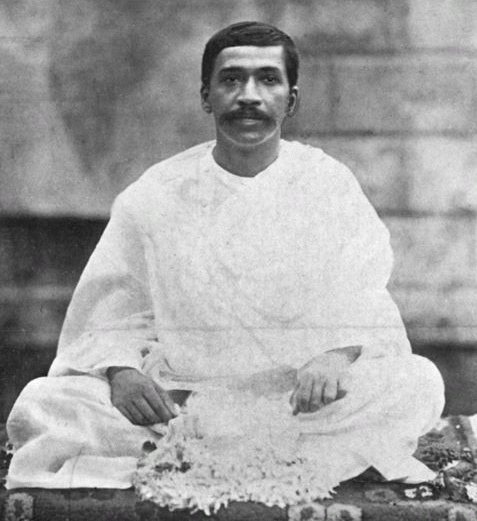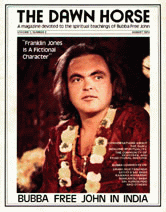
Sir Aurobindo – 1907

VOL. 1. NO. 2. August, 1974.
BUBBA
FREE JOHN IN INDIA
Conversations About The Guru,
Genuine Spirituality, The Community Of Devotees, And
Traditional Seeking. Bubba Comments On: Swami Muktananda,
Sathya Sai Baba, Ramana Maharshi, Nimkaroli Baba,
Sri
Aurobindo And Others.
Adi Da Samraj: This is really
just a visionary or mystical yoga. Aurobindo and the Mother
were not truly saints, not sages, not Siddhas, just yogis of
a peculiar kind. It is a Westernized yoga. In the West there
is a kind of mysticism that doesn’t generate a spiritual
force. It is just an occupation with internal aesthetic
imageries, not of the kind that true yoga depends on. It
doesn’t have any fire. It is mystical rather than yogic in
the traditional Hindu sense. So Aurobindo saw a lot of
visions, had a sort of intellectual system in which he
synthesized the spiritual culture of this country and added
a certain evolutionary notion to it.
Hegel was a great philosopher of the
last century who was very much like Sri Aurobindo. He
synthesized Western philosophy and wrote volumes of endless
logical and aesthetic considerations. He created a
systematic approach to philosophy. Somebody once said that
if at the end of his life he would have said that it all was
nonsense, Hegel would have been the greatest philosopher
that ever lived, but since he did not, he was probably the
worst philosopher that ever lived! The same irony may be
applied to Sri Aurobindo. He was a vast systematizer,
synthesizer of all kinds of considerations regarding the
spiritual culture historically found in India and elsewhere.
If at the end of his life he had said that everything he had
said was beside the point, he would have been a great
spiritual teacher, not a Guru in the true sense, but a
spiritual teacher.
Since he did not, he is one of the
worst. Because his teaching is just stuff, preoccupation,
something that attracts people at a level that is not of
great value. It gives them more to accumulate and
assimilate, more to which they may adapt and bind
themselves. It prevents the process of Truth.
The principle of spiritual life is a
fire. It produces a crisis in consciousness that is
penetrating, illuminating. But the principle of sadhana in
this Ashram does not serve this crisis. It is based on the
principle of accumulation, assimilation, and adaptation. In
other words, it is a cultural experience. The same thing
goes on here that goes on in any idealistic religious
community anywhere in the world.
It is just an aesthetic cultural
order in which people have associated the life and mind with
Divine principles and truisms, with ideas. That is
fundamentally what’s going on here. The principle of real
sadhana, of Truth, the principle of this crisis, does not
exist in this environment, because people are not involved
in any such process. The concern here is for transformation.
There is an obsession with transformation, a fetish for
transformation. Everybody is looking for the transformation
to occur. The transformation as a goal, sought through
various methods, is simply the search again, but no
transformation occurs without this fundamental crisis. In
this crisis all concerns are undone, even the concern for
transformation.
Sri Aurobindo’s contributions are
essentially literary and cultural. His basic motivation was
political. He was a political activist early in his life,
and he saw that political change depended on the
transformation of individuals and all that, so he began to
get into spiritual ideas. He was educated in Europe and had
a very Westernized mind. The Mother is a French woman. They
both have added to this Indian notion of separation from the
world the Western idea of evolution and transformation of
the world. His basic political motivations were expanded
into this notion of spirituality and human transformation
and evolution. So his contribution is essentially cultural.
It’s a political rather than a spiritual philosophy in its
truest sense. It produces a culture, not spiritual life. It
is an association with ideas and ideals, a very literary and
mental and really very Western kind of
preoccupation.
In India there is certain value to
turning to a practical order of life, since the ancient
tendency is to abandon life. But that doesn’t mean anything
like real sadhana is involved in the principle of this
community. It’s just a utopian United Nations, World’s Fair,
university idea. There is no spiritual source of any
profundity alive here. The samadhi site of Sri Aurobindo is
the only one I have ever visited that was just a grave.
There is no force, no penetrating influence coming from it.
Neither is there the orientation to the genuine fire of
spiritual grace, nor the orientation of individuals toward
that quality in themselves which becomes this crisis of
Truth. So it is a very mediocre, accumulating
community.
Auroville accumulates thoughts,
ideas, functions. Then it assimilates into itself all these
various ideas, ideals, thoughts, and functions, and adapts
to them, producing an order of life based on this system.
That is the way culture grows, but it is not the way the
spiritual crisis develops. That is another thing entirely.
Order in itself is fine. Just as the universe is ordered,
there must be order in any functional system. But here order
is the preoccupation. Order is a thing in itself, so there’s
lots of ordering going on, but at the core of this ordering
there is nothing but the intention to order, the intention
to create a community on ideal lines. Therefore, the order
becomes oppressive from the point of view of
Truth.
There is no fire, no life, no
freedom, and yet these things are part of the language of
the literature of this community. As in any other merely
idealistic community, all these things are contained in the
literature, not in the spiritual life. Christianity is
loaded with the same kind of idealism, but only here and
there throughout the whole history of Christianity have
there been any great saints who have had this fire. It is
the same here. It is just a system of ideals of religious
community. Here and there there may be a great individual,
as in any other cultural setting, but the community itself
is not based on literal contact with the Divine
Siddhi.
From a political, cultural, and
social point of view, there are some nice things going on
here. Just as you might say the United Nations is a nice
thing. But from the point of view of Truth, this is not a
genuine Ashram. It’s a sort of literary and cultural event
around which all people can come and say, “Yes, we believe
in this together,” and create a United Nations of spiritual
life.
All of that is good, but if the
whole world took on this particular form of community, it
would still be necessary for the Guru to appear. Their
assumption is that the Guru is somehow contained in this
community. But the Guru would have to come to save this
community, to bring the dharma of true spirituality into it.
It is like any other community, an order of life and mind
with certain spiritual ideas behind it. They are very busy
creating this enormous World’s Fair community. But all of
that should be produced after this crisis of transformation,
the true, spontaneous transformation. When there are
individuals who are truly living in the fire of Truth, then
they can perhaps go about creating a community. But here
they are creating the artifice first. There is all this
nonsense about the future beings we are going to have on
this planet. They will be a new race of beings, they will be
greater than men, they will have no sex, they will be
immortal, and all this craziness.
Ramana Maharshi commented on
Aurobindo’s point of view. He said that throughout the
history of spiritual life there have constantly been these
guys who appeared and created a philosophy of transformation
according to which the body would be made immortal and all
these events would create a superior man. It has always been
happening. There have always been such people. They
represent one of the potential points of view, but they do
not make it true. It has nothing to do with Truth. Aurobindo
says, “Yes, there is Self-realization, realization of the
Atman must occur, but then that’s not the end. After it
occurs then there is this other transformation in which the
spiritual Light is brought down.” That was just an offhand
comment. There is nobody here doing anything that’s going to
bring about the realization of the Self. It is true, though,
that once the Self is realized there does tend to be Siddhi,
a transformation is spontaneously activated, without any
concern whatsoever on the part of the individual. This thing
just tends to occur in some form or other in such a case. It
doesn’t mean that the individual is going to become immortal
or anything like that, but a transforming process does tend
to be activated in him.
more on Aurobindo